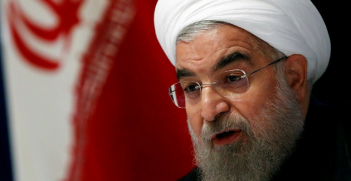Iran: Autocracy in the Age of Coronavirus

Iran’s conservatives are being voted back into power. But with the range of challenges Iran faces, including the accelerating spread of Coronavirus, might these have been good elections to lose?
During a week in Qatar earlier this month, I found the approach of many observers there to Iran’s shifting power dynamics unusual. Some of those I spoke with had just returned from Iran where they had monitored the parliamentary (Majlis-e Shoura) elections first-hand. They acknowledged that the elections showed how legislative and executive power was shifting decisively to Iran’s conservatives after eight years of centrist-reformist government led by President Hassan Rouhani. But several wondered if the conservatives’ victory could blow up in their faces.
Iran’s legislative elections won’t be completed until a second round of voting on 17 April – the first round was on 21 February. But it’s already clear that conservatives have won very big, with centrists-reformists reduced to a rump. In the lowest voter turnout since the 1979 revolution – official figures indicate 42 percent of the electorate voted, compared with 62 percent in 2016 – the conservatives have so far won 221 of 279 decided seats. That’s 76 percent of the vote, with 11 seats still to be determined in the second round voting. Reformists and centrists won less than seven percent of the vote, compared with nearly 45 percent in 2016, and have been reduced to a rump of 20 seats from 121, which had given them a governing plurality in 2016.
The result followed blatant manipulation of the candidate nomination process by the regime – which is separate from the formal government and comprises Supreme Leader Ali Khamenei and his chosen inner circle, including senior representatives of the Islamic Revolutionary Guard Corps (IRGC). The Council of Guardians, a body of 12 clerics and jurists which, under Iran’s constitution, vets candidates on the regime’s behalf, disqualified the majority of reformist-centrist candidates from running (see “Iran’s Crisis Election”). That led many non-conservative voters to boycott the election. The actual turnout could have been even lower than the official 42 percent.
So why might this have been an election that could have been better to lose? Consider the US presidential election of 1928, won decisively by Republican candidate Herbert Hoover. Unusually among US presidential aspirants, Hoover had excellent qualifications for the job. He had a proven record in competent administration as a cabinet secretary and in several other government and private sector roles. In normal circumstances, he could have served at least two terms – at that time there were no term limits for US presidents. Then came the Great Depression in 1929 which, pre-Keynes, the industrialised world was ill-equipped to counter. Hoover consequently lost badly to Franklin D. Roosevelt in 1932, and the Republicans were shut out of the White House until 1952.
Plethora of problems
It is unlikely that any of Iran’s conservatives have this US precedent in mind. But look at the plethora of problems they are set to inherit when the new parliament sits in May – and which will almost certainly be worse in May next year when a likely conservative president is elected.
First, the Trump administration’s policy of “maximum pressure” has made it impossible for Iran to export oil in significant quantities. Exports in February were less than 250,000 barrels per day, a tenth of the quantity Iran exported before the US withdrew from the Iran nuclear agreement and re-imposed sanctions in 2018.
The income Iran receives from the meagre amount it manages to export (Iran understandably does not disclose the destinations) has been reduced by the production dispute this month between Saudi Arabia and Russia, which is driving down the price of oil. As oil is the regime’s main source of income, the impact on the economy and employment has been devastating: the IMF estimates that Iran’s economy shrank by 9.5 percent in 2019 and 4.8 percent in 2018. The outbreak of the Coronavirus pandemic will inevitably produce negative growth for a third successive year.
Second, the Trump administration, in an election year and under pressure from Coronavirus and its impact on the US economy, is itching for a way to distract and appease its base. A strike on Iran that can be justified on self-defence grounds would suit this purpose well. This circumscribes Iran’s foreign activity – the regime knows it would come off badly from any military engagement with the US – and makes Iran seem powerless in the face of external threats.
Third, the impact of these two factors has been severely aggravated by the rapid spread of Coronavirus in Iran since February, which the Iranian authorities don’t have the skill or resources to counter. It’s now clear they initially downplayed the extent of the virus – not least to try to ensure a reasonable turnout in the Majlis elections. According to sources I spoke with in Qatar who were in Iran for the elections, Iranian authorities insisted on opening polling booths in Qom, despite the obvious risk to public health.
Reports from Iran indicate shops and offices were still largely open last week, and provinces were implementing restrictions on public activity inconsistently. The regime has now reportedly ordered responsibility for control of the virus to be taken from the Rouhani government and given to the IRGC with orders to use harsh measures to clear the streets. That may be too little, too late: there are reports of satellite imagery showing mass graves being prepared in Qom.
Spread of the virus within Iran could now be the worst of any country outside China. Reports that two vice-presidents and almost ten percent of current Majlis members are among those infected, with two Majlis members and several senior officials having died, suggest an incidence far greater than officially acknowledged.
The regime reports around 1,135 deaths and 17,161 infected. But a forensic analysis by The Atlantic makes a solid case for actual infection numbers in excess of a million. Even when a vaccine is developed, the regime’s suspicion of external plotting (it has blamed the virus on US bio-warfare) may delay introduction of the vaccine into Iran, thus prolonging the disease’s grip on the country.
Fourth, popular distrust of the regime appears to be increasing, as shown by demonstrations against price rises last November and over Tehran’s initial denial of responsibility for the shooting down of a Ukrainian airliner in January. More public expressions of anger are likely as the country’s economic and public health crisis worsens.
A final factor is that Iran’s conservatives are far from monolithic. The size of the conservative majority is likely to encourage factionalism – a further obstacle to crafting coherent government responses to the challenges Iran will face over the coming parliamentary and presidential terms.
With Rouhani in charge, he and the reformists/centrists who support him could be blamed for the almost insuperable problems Iran faces currently and probably well into the future. But Rouhani is now a lame duck and can’t be used as a scapegoat for much longer. Iran’s conservatives are set to inherit a mess, and there is no sign they have a strategy for dealing with it.
Ian Parmeter worked for 37 years in the Department of Foreign Affairs and Trade, the Department of the Prime Minister and Cabinet, and the Office of National Assessments. He is currently a Research Scholar at the Centre for Arab and Islamic Studies, Australian National University.
This article is published under a Creative Commons Licence and may be republished with attribution.





